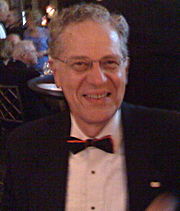 Vice-President Tom Crowley is delighted to report that Dr Joe Taylor, K1JT will be our keynote speaker at the Green Bank SARA Conference 29 June - 2 July. A short bio of Dr Taylor follows:
Vice-President Tom Crowley is delighted to report that Dr Joe Taylor, K1JT will be our keynote speaker at the Green Bank SARA Conference 29 June - 2 July. A short bio of Dr Taylor follows:
Taylor immediately went to the National Radio Astronomy Observatory's telescopes in Green Bank, West Virginia, and participated in the discovery of the first pulsars discovered outside Cambridge. Since then, he has worked on all aspects of pulsar astrophysics. In 1974, Hulse and Taylor discovered the first pulsar in a binary system, named PSR B1913+16 after its position in the sky, during a survey for pulsars at the Arecibo Observatory in Puerto Rico. Although it was not understood at the time, this was also the first of what are now called recycled pulsars: neutron starsthat have been spun-up to fast spin rates by the transfer of mass onto their surfaces from a companion star.
The orbit of this binary system is slowly shrinking as it loses energy because of emission of gravitational radiation, causing its orbital period to speed up slightly. The rate of shrinkage can be precisely predicted from Einstein's General Theory of Relativity, and over a thirty-year period Taylor and his colleagues have made measurements that match this prediction to much better than one percent accuracy. This was the first confirmation of the existence of gravitational radiation. There are now scores of binary pulsars known, and independent measurements have confirmed Taylor's results.
Taylor has used this first binary pulsar to make high-precision tests of general relativity. Working with his colleague Joel Weisberg, Taylor has used observations of this pulsar to demonstrated the existence of gravitational radiation in the amount and with the properties first predicted by Albert Einstein. He and Hulse shared the Nobel Prize for the discovery of this object. In 1980, he moved to Princeton University, where he was the James S. McDonnell Distinguished University Professor in Physics, having also served for six years as Dean of Faculty. He retired in 2006.
Amateur Radio
Joe Taylor first obtained his amateur radio license as a teenager, which led him to the field of radio astronomy. Taylor is well known in the field of amateur radio weak signal communication and was assigned the call sign K1JT by the Federal Communications Commission (FCC). He had previously held the callsigns K2ITP, WA1LXQ, W1HFV, and VK2BJX (the latter in Australia).[2] His Amateur Radio feats have included mounting an 'expedition' in April 2010 to use the Arecibo Radio Telescope to conduct moonbounce with Amateurs around the world using voice, Morse Code, and digital communications.
He wrote several computer programs and communications protocols, including WSJT ("Weak Signal/Joe Taylor"), a software package and protocol suite that utilizes computer-generated messages in conjunction with radio transceivers to communicate over long distances with other amateur radio operators. WSJT is useful for passing short messages via non-traditional radio communications methods, such as moonbounce and meteor scatter and other low signal-to-noise ratio paths. It is also useful for extremely long-distance contacts using very low powertransmissions.
